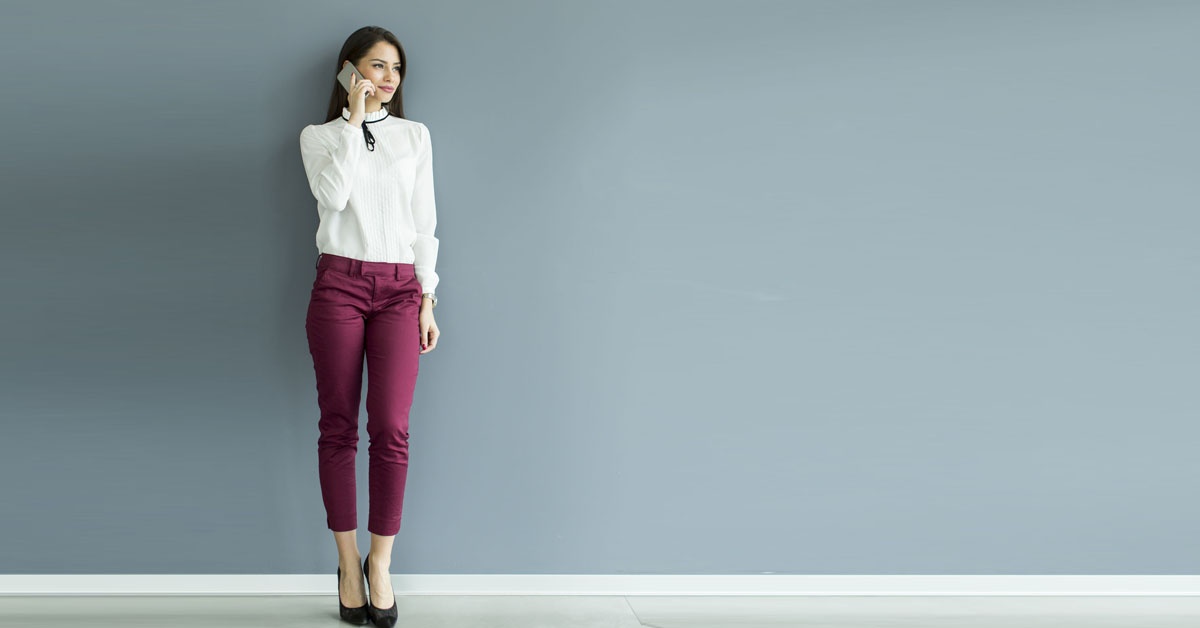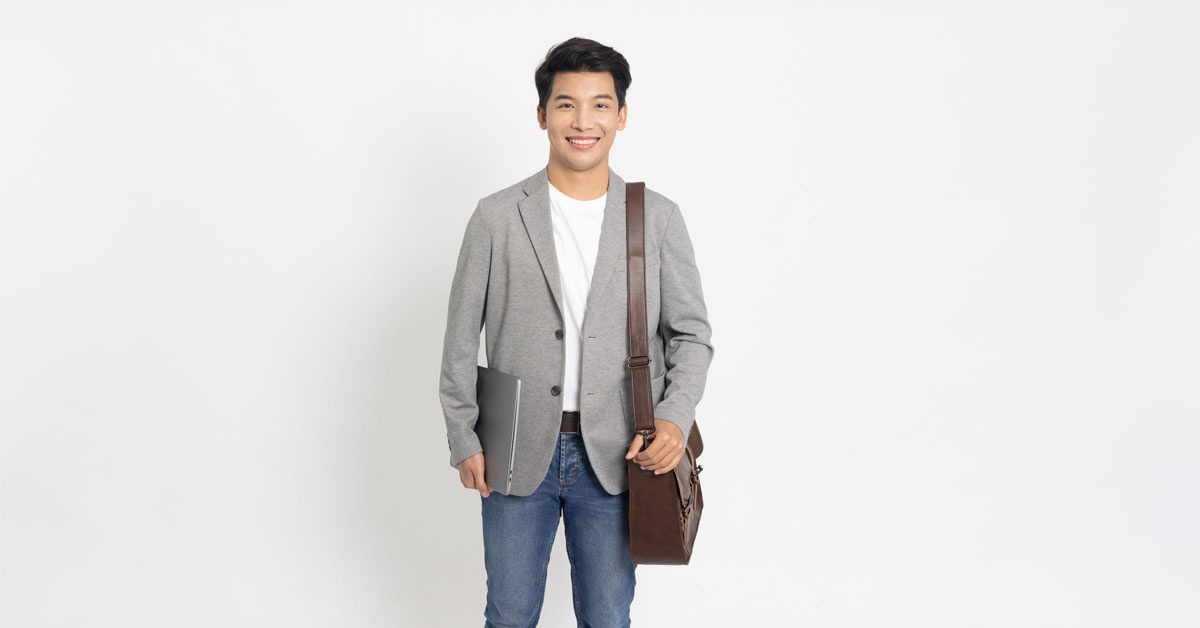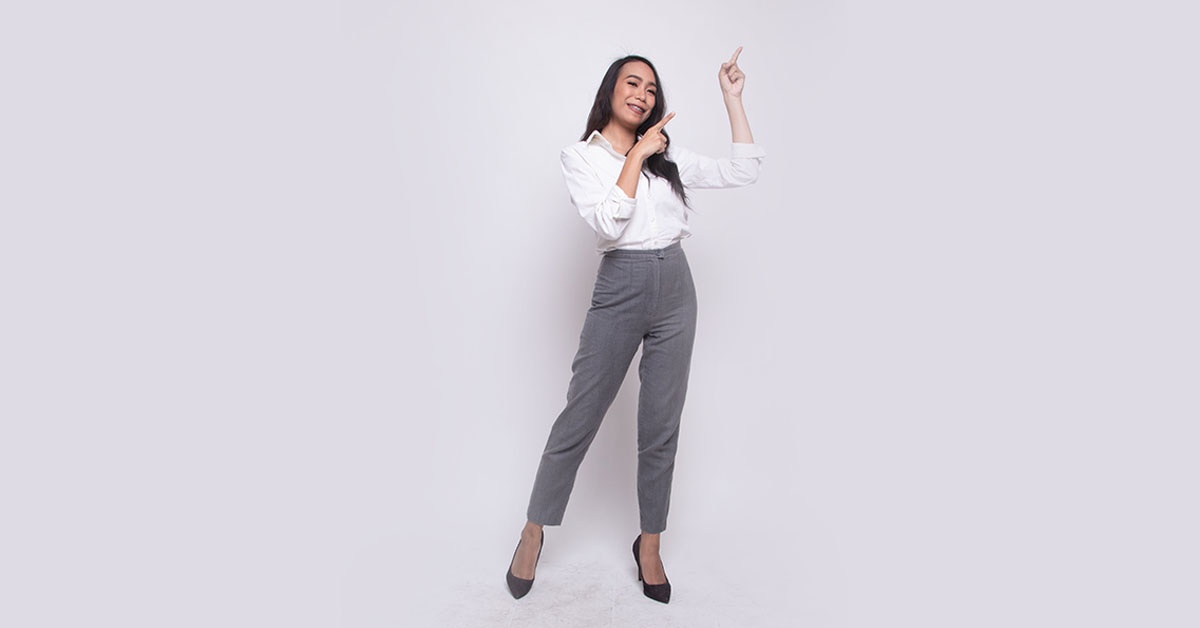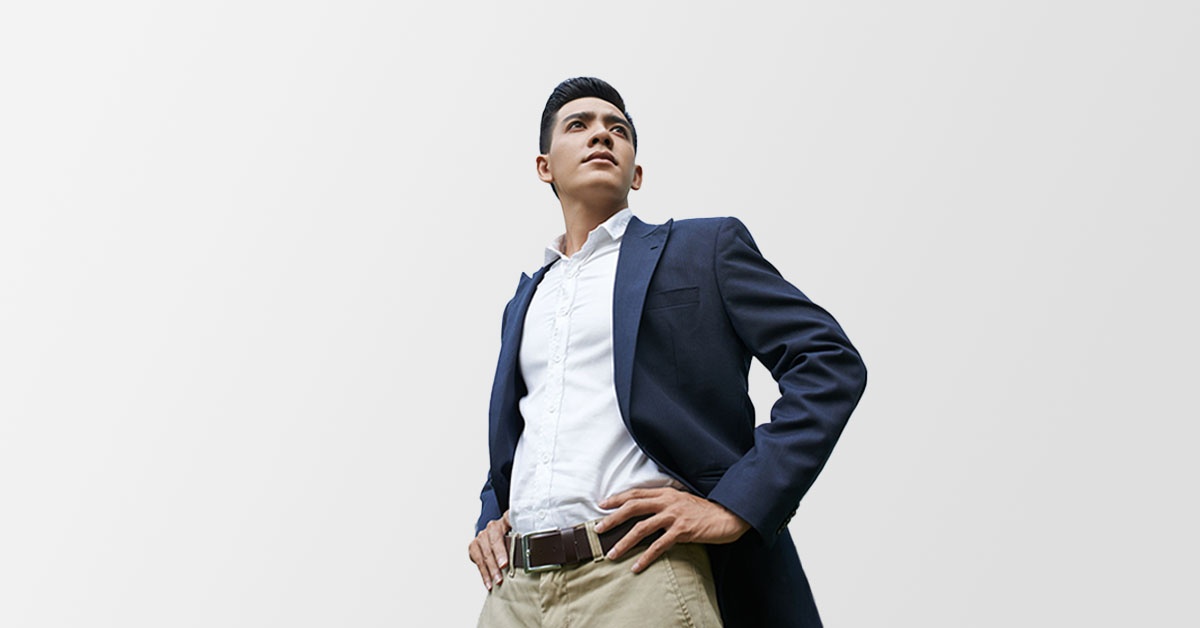Business casual attire in 2023: How to dress to impress
Business casual attire is a type of dress worn in many workplaces. The business casual dress code is less formal than traditional business apparel while maintaining a professional appearance. Remember the power suits fromJames BondandMen in Black? Add a few relaxed tweaks here and there. The style works well in Singapore, where jackets and long-sleeved button-downs might be too warm.
Since business casual fits somewhere between stiff and easier clothing, combining elements from both dress codes for business casual outfits is the secret to nailing it. Imagine a suit without a tie, jeans with a blazer, and neutral-coloured lace-up sneakers. For women, you can try knee-length skirts or dresses. Add smart accessories like a belt, scarves, or tasteful jewellery. There's no shorthand definition, so think of these keywords: appropriate, decent, and clean. We'll get to the details later.
- The importance of dressing appropriately in the workplace
- Understanding business casual attire
- Differences between business casual and business formal
- Business casual attire for men
- Business casual attire for women
- Gender-neutral business casual attire
- What not to wear in business casual settings
- How to dress for specific occasions
- Tips for choosing business casual clothing
- Dressing for success
- Summary
- Frequently asked questions (FAQs)

Many workplaces and events opt for a business casual dress code because it looks professional while exuding comfort and flexibility. It's also more approachable.
The importance of dressing appropriately in the workplace
A study in the Journal of Experimental Social Psychology introduces the term "enclothed cognition.” It describes the influence that clothes have on the wearer's psychology. In the experiment, three sets of subjects received the same coat. Group 1 had a "lab coat", Group 2 had a "doctor's coat", and Group 3 had a "painter's coat". Results show that those in the first two groups showed more focus and attention.
Fashion psychologist Karen Pine of the University of Hertfordshire toldForbesthat clothing holds symbolic power : "When we put on an item of clothing, it is common for the wearer to adopt the characteristics associated with that garment. A lot of clothing has symbolic meaning for us, whether it’s ‘professional work attire’ or ‘relaxing weekend wear’, so when we put it on, we prime the brain to behave in ways consistent with that meaning."
You can see how appropriate workwear gets you physically and mentally ready to dive into your job. It sends a message to co-workers, superiors, and clients about your professionalism, competence, and attention to detail. Dressing unsuitably can send the wrong message and potentially harm your or your company's reputation and prospects. Remember that the emphasis is still on the “business” part of business casual!
Benefits of wearing business casual attire

- Helps distinguish between your professional and personal life
- Makes people more comfortable and confident in the workplace
- Creates a terrific impression, which is why you need to dress well during a job interview
- Promotes company culture and team unity
- Establishes professionalism
- Helps avoid potential embarrassment or negative feedback from superiors or clients.
Additionally, wearing business casual outfits can help individuals stand out in the workplace and create a lasting impression.
Understanding business casual attire
In 2018, PwC Singapore shook up dress code policies when it announced a “FlexDress Everyday” policy. Instead of business formal, the new rule encouraged employees "to dress responsibly and exercise good judgement, making the right decisions on their appropriate outfit for the day”.
The goal was a practical one. PwC's Trillion So stated that the company was excited to go against the grain and enable employees "to be themselves, unlocking the diversity each of us brings to the workplace”.
It spurred a debate about relaxing the rules. When Millennials took over the labour force and preferred companies with flexible hours and easy-going dress codes, the game changed entirely. Business casual became the preference.
A study on the perception of attire style in the workplace showed that business casual dress code was a “happy medium” in the workplace, with respondents mentioning only positive attributes. Business casual clothing was rated as more ethical compared to casual attire.
Ultimately, nailing business casual is more about how you style yourself than the elements of your outfits. Before stepping out, look in the mirror and ask yourself if you look respectable.
Differences between business casual and business formal
Business formal attire typically consists of a suit and tie for men and a suit or dress for women. Meanwhile, business casual attire allows you to be more flexible with your clothing choices. A jacket, blazer, or tie may be unnecessary in some business-casual environments.
Here are some easy rules to follow for business casual clothes:
- Nothing ripped. Skip the torn jeans, shredded hems, or distressed denim.
- Colour matters. Neutral hues, especially black, can create an impression of professionalism and formality.
- Fabrics make a difference. Business formal clothes employ stiffer textiles that must look crisp and pressed. Business casual outfits usually allow for cotton, chino, and twill.
- Avoid anything you would wear to the gym and beach – or to sleep!
- Cover up. Cropped tops, large armholes, or overly plunging necklines are a no-no.
Determining what is appropriate in your workplace can be more challenging. Understand the expectations of your employer and your colleagues regarding business casual or business formal dress codes. Some workplaces may have a specific policy, while others may give more allowance.
When in doubt, err on the side of caution and dress more conservatively. Observe your colleagues to see what is allowable. If you are still unsure, asking your supervisor or Human Resources representative for guidance is always a good idea.
Business casual attire for men
The definition of business casual can vary based on location and general culture. Tatler says business casual for men “translates to a blazer or sports coat and a solid colour collared shirt or dressed up T-shirt with dark trousers or khakis.”
Examples of business casual attire for men

Shirts
Whichever option you choose, if you work in an office, your casual business shirts should fit well and be tucked in without wrinkles or stains. Loud patterns may be seen as unprofessional.
Dos:
- Dress shirts
- Polo shirts
- Collared shirts
- Plain T-shirts
Don’ts
- Tees with graphic designs
- Shirts with bold prints
- Shirts with rips or holes
Pants and trousers
Pants and trousers should be dressy and conservative. While companies used to frown on business casual jeans, workplaces are becoming more accepting of darker, better-quality denim.
Dos:
- Slacks
- Khakis
- Corduroys
- Dark, dressy denim jeans
Don’ts:
- Joggers
- Ripped or faded jeans
- Very tight pants
- Very baggy pants
Jackets and blazers
Jackets and blazers can be worn in some business casual environments, although they are not always necessary. A sports jacket or blazer can add a dressy touch to an outfit and looks great over a collared shirt or sweater.
Dos:
- Sport coats
- Unlined blazer
Don’ts:
- Loud or printed jackets
- Overly casual jackets
- Motorcycle jackets
Shoes
Generally, men should not go open-toed in the workplace.
Dos:
- Loafers
- Dress shoes
- Oxfords
- Plain, classic sneakers
Don’ts:
- Sandals
- Flip-flops
- Chunky sneakers
Accessories
Stick to classic accessories in the office.
Do wear:
- Belts that match your shoe colour
- Watches
- Cufflinks
- Pocket squares
- Plain ties, as needed
Don’t wear:
- Chunky belts
- Printed ties
For inspiration, you can watch the following films to understand how to pull off business casual for men.
- Ryan Gosling in Crazy, Stupid Love
- George Clooney in Ocean’s Eleven
- Ryan Reynolds in Red Notice
Business casual attire for women
Tatler'sTania Jayatilaka sums up business casual attire for women as follows: “A blouse with a skirt or pair of slacks is fine.” Dressy, elegant outfits with tailored silhouettes work perfectly for women looking to nail the business casual dress code.
Examples of business casual attire for women

Tops and blouses
Your top should have a good fit and be appropriate for the workplace.
Dos:
- Collared shirts
- Blouses
- Sweaters
Don’ts:
Tops that are too revealing, too casual, or too flashy
Skirts and dresses
A simple dress or skirt with a conservative neckline or wrapped up in a light sweater or cardigan can create a professional look.
Dos:
- Knee-length dresses and skirts
Don’ts:
- Skirts that are too short, tight, or revealing
Pants and trousers
When choosing bottoms, consider fit, quality, comfort, and flexibility. No, don't wear your Spandex. Your pants should work well with many items in your closet. Fortunately, women can typically get away with work pants in different silhouettes, from straight cuts to loose drapes.
Dos:
- Slacks
- Khakis
- Corduroys
- Dark, dressy denim jeans
Don’ts:
- Joggers
- Tights
- Ripped or faded jeans
- Very tight pants
- Very baggy pants
Jackets and blazers
A blazer can add a dressy touch to a power outfit. You can wear it over a collared shirt, sweater, or dress. The right business casual jacket may even let you get away with more casual clothes.
Shoes
Women can get away with more shoe types in the workplace, so long as it's not overly casual.
Dos:
- Flats
- Loafers
- Low heels
- Plain and minimalist sneakers
Don’ts:
- Chunky sneakers
- Sandals
- Flip-flops
Accessories
You should match your accessories to the context of your office. More conservative settings might require a bare minimum. Some workplaces also prohibit jewellery as a safety precaution. Of course, if you work in creatives or the fashion industry, you can usually get away with anything.
Dos:
- Simple jewellery
- Watch
- Scarf
- Statement necklace
Don’ts:
- Excessively large or loud jewellery
For inspiration, you can watch the following films to understand how to pull off business casual for women.
- Anne Hathaway inThe Intern
- Rose Byrne inLike a Boss
- Philippine Leroy-Beaulieu inEmily in Paris
Gender-neutral business casual attire
While Singapore is well-known for being conservative, it is open to diversity policies and has never strictly enforced prohibitive laws against gender orientation and sense of style.
Examples of gender-neutral business casual attire

Oversized blazers and trousers
Oversized blazers and trousers can help create a high-impact business casual, genderless outfit. The key here is to mix silhouettes to avoid looking sloppy. For example, pair an oversized blazer or trousers with a tailored shirt. Stick to neutrals instead of loud colours for work-appropriate business casual outfits.
Minimalist jumpsuits
Minimalist jumpsuits can help you look streamlined and, as a bonus, taller. It is an effortless way to look polished and put together. You can wear a minimalist jumpsuit on its own or pair it with an appropriate jacket.
Button-down shirts with tailored trousers
Wearing button-down shirts with tailored trousers is a staple in business casual dressing. It is a classic because it makes the wearer look polished and dignified – not to mention androgynous.
Layering with sweaters and vests
Layering with sweaters and vests can help you add variety and style to your business casual wardrobe while maintaining a professional appearance. Stick to neutrals, and pair them with dress pants or chinos for a pulled-together look.
For inspiration, here are some pegs to look at for gender-neutral business attire.
- Diane Keaton in Annie Hall
- Taylor Mason in Billions
- Sandra Bullock (when she’s not undercover) in Miss Congeniality 2
What not to wear in business casual settings
Items to avoid in the workplace:
- Logos
- Graphic T-shirts
- Ripped clothing
- Short shorts
- Flip-flops
- Sandals
- Athletic wear
- Revealing or provocative outfits
Dressing too casually
While jeans and sneakers may be acceptable in some workplaces, if you are unsure, dress a little more formally than you need to. Coco Chanel's quote about the benefits of underdressing doesn't hold in the workplace.
Avoid wearing house clothes or anything that would count as underwear.
Overdressing
Overdressing might also be an issue. Tails and a tie may be too formal for a business casual environment. Strike a balance between looking professional and being too formal. While it is good advice to dress slightly more formally than your coworkers, you should not look too formal that you look out of place.
How to dress for specific occasions
Business casual attire for interviews
For job interviews, you want to make a memorable first impression. Opt for a tailored suit or dress pants with a blazer, a dress shirt, and dress shoes. Avoid anything too flashy or revealing, and stick to neutral colours.
Business casual attire for conferences and meetings
This could include dress pants or khakis with a dress shirt, a blazer, and dress shoes. Women could wear a blouse, dress pants, a skirt, and comfortable yet professional shoes.
Business casual attire for networking events
You also want to make a good impression while networking. A business-casual outfit like a dress shirt with chinos, dress shoes, and a leather belt would be appropriate for men. Women could opt for a blouse with a skirt or dress pants and a comfortable yet professional pair of heels.
Business casual attire for laid-back workplaces
Some industries, such as tech, advertising, and creatives, don’t usually enforce strict dress codes. If your workplace has lax policies on dress styles, you can probably get away with anything. However, focus on what youshouldn’twear, such as house clothes, slippers or flip-flops, swimming attire, and anything threadbare with holes or tears. Go for being decent and well-groomed.
Business casual attire for Casual Fridays
Many companies have "Casual Fridays," allowing employees to dress more casually. However, casual doesn't mean unkempt. Opt for dark-washed jeans, a dress shirt, and dress shoes for men or a nice blouse and dress pants for women. In companies where employees wear uniforms the rest of the week, business casual can still mean a degree of uniformity, such as a collared shirt with the company logo and nice jeans instead of the usual suit.
Business casual attire in different work settings
As mentioned above, some industries have different ideas of the business casual dress code, based on the setting and the people who work there. The advertising, television, or entertainment industries encourage more self-expression in people, so bold colours and dramatic accessories are common. People who work in fashion are almost expected to not follow any “rules” when they’re in an office, as long as they can do their work!
Tech people spend a lot of time working in front of computer screens, so they prefer to be as comfortable as possible without looking inappropriate. People in banking and finance dress more conservatively – perhaps because clients perceive people in suits and neutral colours as being discreet with money matters.
Unless you’re a manager and have to interact with customers, people in the service industry, such as retail institutions or restaurants, are usually in uniform, so accessories and comfortable but decent shoes are key.
In hospitals and the medical field, where clothes are often hidden under scrubs or lab coats and workers are always on their feet, comfort is also essential. Good, presentable shoes are the best choice – nothing too worn-out or dirty. Make sure that what shows under the coat is still professional and appropriate.
Tips for choosing business casual clothing
Find the right fit
When shopping for business casual clothes, focus on pieces that fit well and flatter your body type. Avoid anything too tight or too baggy, and always ensure an appropriate length of sleeves and pants.
Selecting appropriate colours
Colours are essential for exuding professionalism and confidence. Stick to neutral colours like black, navy, grey, and beige for foundational pieces like blazers, pants, and skirts. You can incorporate some colours for shirts, but avoid anything too bright or flashy for the overall picture.
Choosing the right accessories
Accessories can elevate an outfit and add a touch of personality. Opt for simple and understated pieces like a classic watch, a leather belt, or a tasteful piece of jewellery.
Creating a capsule wardrobe
A capsule wardrobe is a collection of essential clothing items to mix and match to create various outfits. Creating a capsule wardrobe for business casual attire can make getting dressed in the morning faster and more efficient. Focus on versatile pieces like blazers, dress pants, skirts, and neutral tops that you can dress up or down.
Don't forget about good grooming
Looking professional isn't just about the clothes you wear. Details can make or break your office look. Practise good hygiene and proper grooming. Make sure your nails are clean and trimmed, your breath is minty-fresh, and your hair combed and styled.
Dressing for success
The importance of looking professional
In a professional setting, how you present yourself can communicate much about your competence, reliability, and attention to detail. Dressing professionally is especially essential in a client-facing or management role. It conveys a sense of respect for yourself, your colleagues, and your clients.
How business casual attire can boost confidence
Dressing appropriately for the workplace can significantly impact your confidence and self-esteem. When you look and feel put-together, you are more comfortable in your skin and more likely to feel confident in your abilities. It can help you navigate the challenges and demands of the workplace.
How dressing appropriately can affect career advancement
Dressing professionally and appropriately can also positively impact your career advancement. It demonstrates your ability to follow company standards and expectations and helps you establish a positive reputation in your workplace. A study in the Journal of Business Research reveals that leaders can use their clothes to impact how others see their charisma.
Additionally, dressing well can help you to be taken more seriously and considered for more advanced roles and responsibilities.
Summary
When choosing your office style, opt for business casual. It's a happy medium between feeling relaxed and looking polished. Mix tailored pieces with dressed-down items. Stick with neutral hues but show off your personality with accessories. Pair your stellar sense of style with good grooming.
Dressing appropriately in the workplace is not just about presenting yourself professionally and respectfully. It can help you build relationships with co-workers and clients and show your commitment to your job and company. A well-chosen business casual outfit can make you look more credible and impressive at work.
Present yourself better at work with tips in our Career Advice page. Don’t forget to sign up for a JobStreet account to see what opportunities could be available for you. You can also download the JobStreet app on Google Play and the App Store.
Frequently asked questions (FAQs)
- What is business casual attire?
A business casual dress code is less formal than traditional business attire but still looks professional. It is typically worn in office settings with a more relaxed dress code.
- What is the difference between business casual and business formal attire?
Business formal attire is a stiff dress code usually worn in traditional workplace settings or significant professional events such as awards ceremonies or dinners. Business casual attire is less formal and is suitable for everyday office wear. It typically allows for more relaxed clothing items like polo shirts, khakis, and loafers. - What is considered appropriate business casual attire for men and women?
Appropriate business casual clothing for men includes dress slacks or khakis, dress shirts or collared polo shirts, and loafers or dress shoes. Women's business casual attire includes dress slacks or skirts, blouses or collared shirts, and closed-toe shoes.
- Can I wear jeans in a business casual setting?
It depends. Some industries, such as creative agencies, may allow dark, dressy jeans as part of their business casual dress code, while others prohibit denim altogether. You shouldn’t wear ripped jeans.
- Are sneakers acceptable in a business casual setting?
The answer varies. Some companies may allow clean, minimalist sneakers as part of their business casual dress code. You can pair them with a blazer or a nice pair of pants. Other places may prohibit them altogether. Look at your bosses and colleagues to see the outfits they wear.
- How can I dress for success in the workplace?
Dressing for success in the workplace involves dressing in a professional manner that aligns with the company's dress code policy. Avoid clothing that is too casual or too revealing. Wear well-fitting clothing appropriate for your body type and the workplace. Accessorise conservatively and keep make-up and hairstyles simple and professional. In today’s everyday workplace, a business casual dress code is the way to go.
